Developing Individuals, Teams and Organisation: A Whirlpool HR Report
VerifiedAdded on 2020/06/05
|19
|5405
|26
Report
AI Summary
This report delves into the critical aspects of human resource development, focusing on the evolution of individuals, teams, and the organization, using Whirlpool as a case study. It begins by outlining the essential knowledge, skills, and behaviors (KSB) required for HR professionals, including knowledge of HRM, psychology, customer service, legislation, and training & development, as well as skills in communication, decision-making, persuasion, and organization. The report then details a skill audit and personal development plan, identifying strengths and weaknesses and outlining goals for improvement. Furthermore, it differentiates between individual and organizational learning, training, and development, highlighting the benefits of inclusive learning. The report also examines the role of high-performance working in employee participation and competitive advantage, and evaluates different approaches to performance management. The report aims to provide a comprehensive understanding of HR development strategies, processes, and their impact on organizational success.
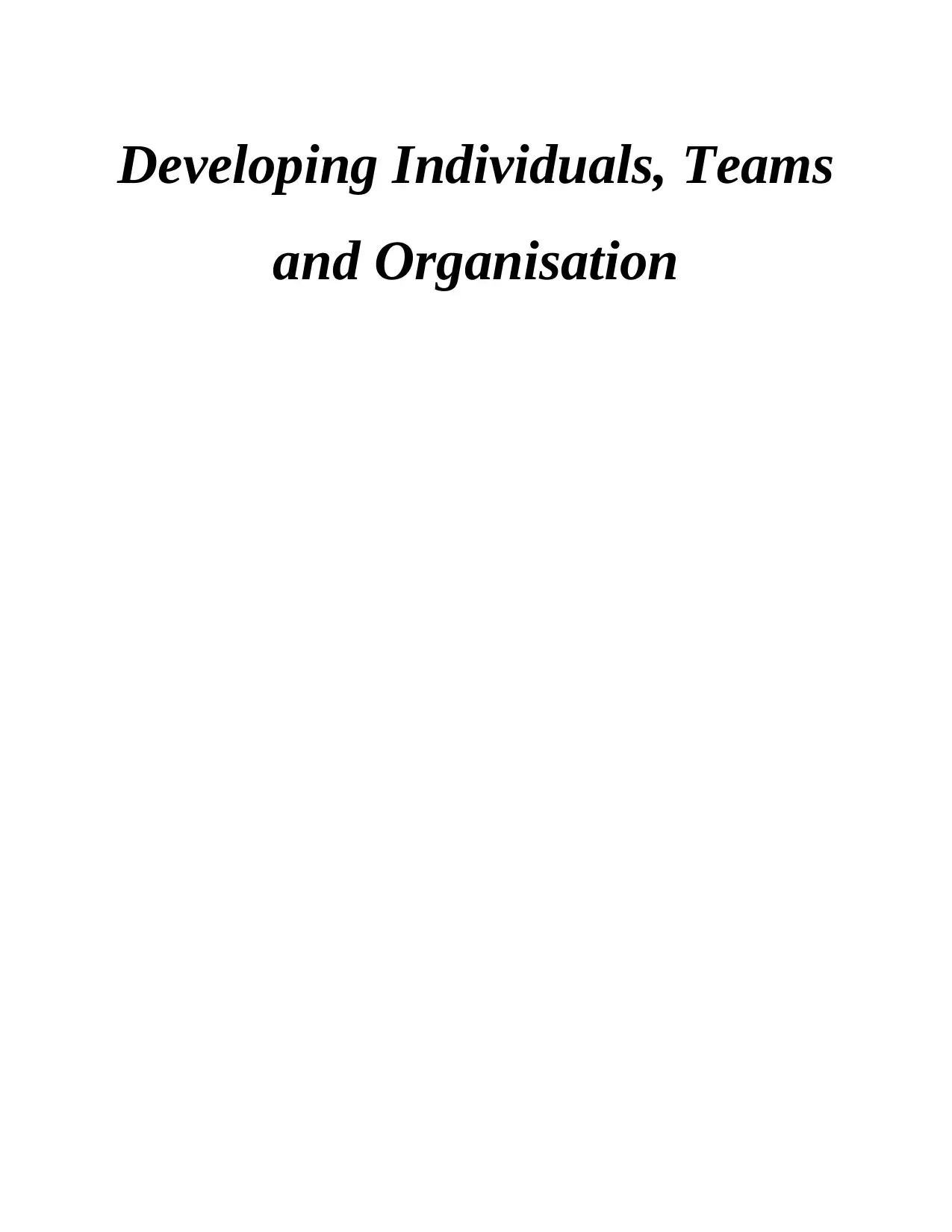
Developing Individuals, Teams
and Organisation
and Organisation
Paraphrase This Document
Need a fresh take? Get an instant paraphrase of this document with our AI Paraphraser
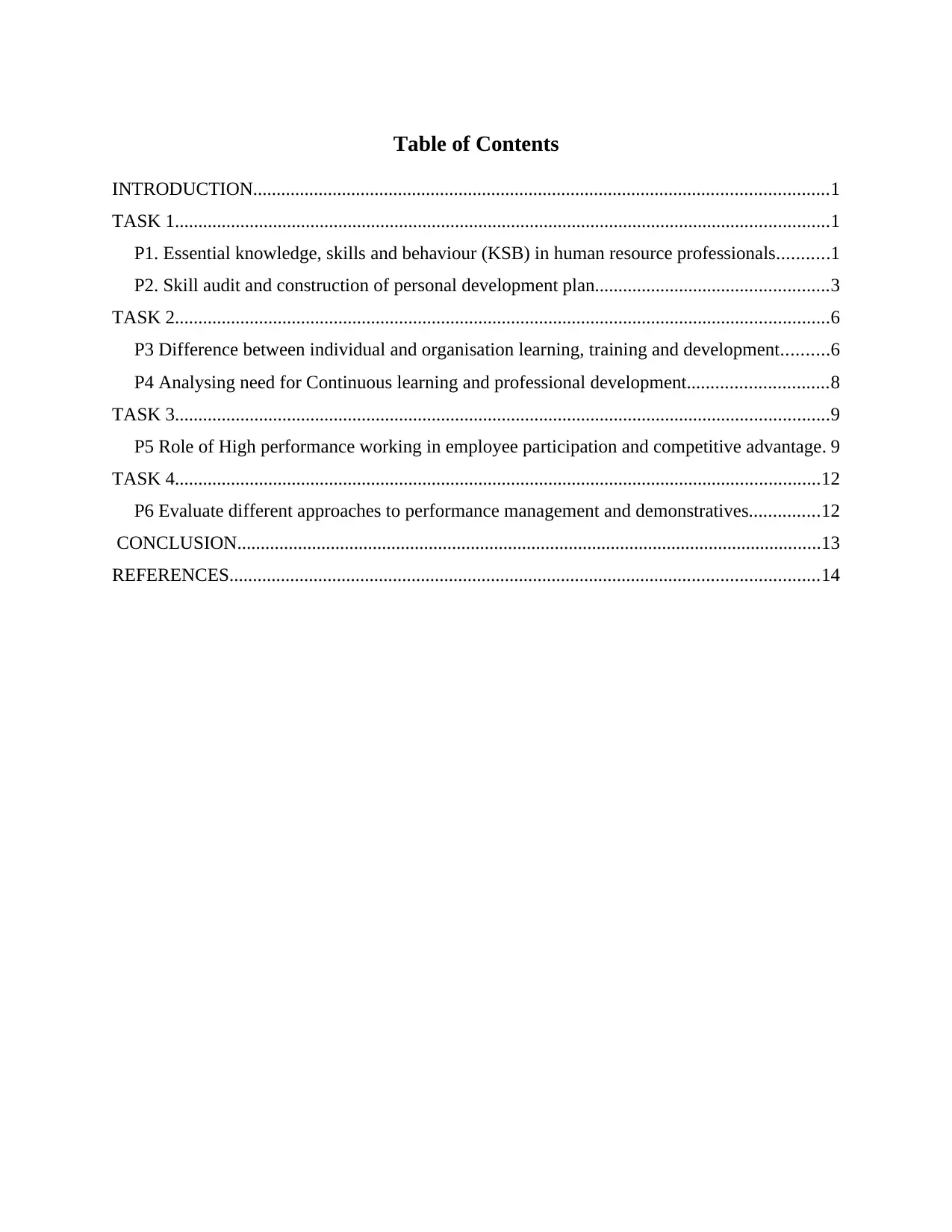
Table of Contents
INTRODUCTION...........................................................................................................................1
TASK 1............................................................................................................................................1
P1. Essential knowledge, skills and behaviour (KSB) in human resource professionals...........1
P2. Skill audit and construction of personal development plan..................................................3
TASK 2............................................................................................................................................6
P3 Difference between individual and organisation learning, training and development..........6
P4 Analysing need for Continuous learning and professional development..............................8
TASK 3............................................................................................................................................9
P5 Role of High performance working in employee participation and competitive advantage. 9
TASK 4..........................................................................................................................................12
P6 Evaluate different approaches to performance management and demonstratives...............12
CONCLUSION.............................................................................................................................13
REFERENCES..............................................................................................................................14
INTRODUCTION...........................................................................................................................1
TASK 1............................................................................................................................................1
P1. Essential knowledge, skills and behaviour (KSB) in human resource professionals...........1
P2. Skill audit and construction of personal development plan..................................................3
TASK 2............................................................................................................................................6
P3 Difference between individual and organisation learning, training and development..........6
P4 Analysing need for Continuous learning and professional development..............................8
TASK 3............................................................................................................................................9
P5 Role of High performance working in employee participation and competitive advantage. 9
TASK 4..........................................................................................................................................12
P6 Evaluate different approaches to performance management and demonstratives...............12
CONCLUSION.............................................................................................................................13
REFERENCES..............................................................................................................................14

⊘ This is a preview!⊘
Do you want full access?
Subscribe today to unlock all pages.

Trusted by 1+ million students worldwide
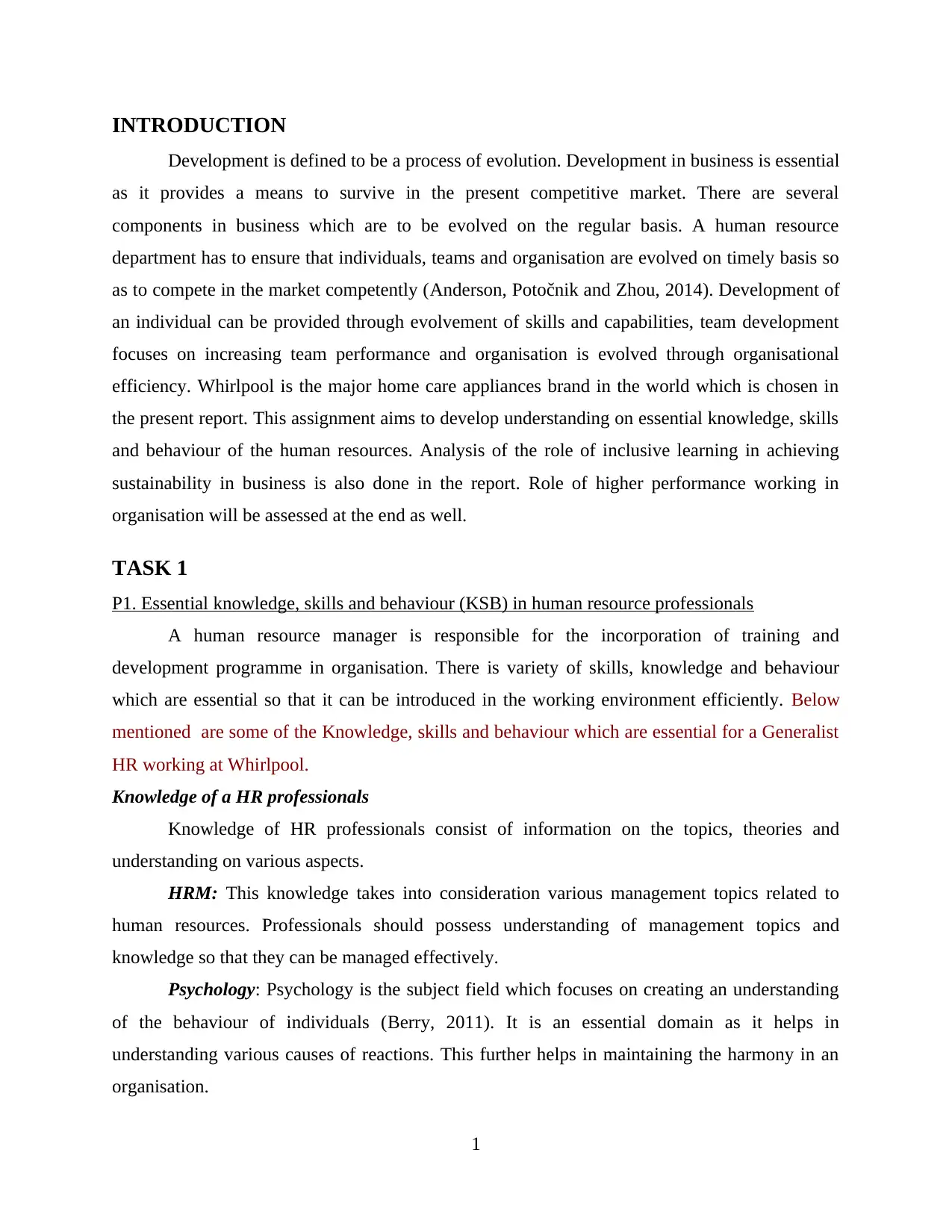
INTRODUCTION
Development is defined to be a process of evolution. Development in business is essential
as it provides a means to survive in the present competitive market. There are several
components in business which are to be evolved on the regular basis. A human resource
department has to ensure that individuals, teams and organisation are evolved on timely basis so
as to compete in the market competently (Anderson, Potočnik and Zhou, 2014). Development of
an individual can be provided through evolvement of skills and capabilities, team development
focuses on increasing team performance and organisation is evolved through organisational
efficiency. Whirlpool is the major home care appliances brand in the world which is chosen in
the present report. This assignment aims to develop understanding on essential knowledge, skills
and behaviour of the human resources. Analysis of the role of inclusive learning in achieving
sustainability in business is also done in the report. Role of higher performance working in
organisation will be assessed at the end as well.
TASK 1
P1. Essential knowledge, skills and behaviour (KSB) in human resource professionals
A human resource manager is responsible for the incorporation of training and
development programme in organisation. There is variety of skills, knowledge and behaviour
which are essential so that it can be introduced in the working environment efficiently. Below
mentioned are some of the Knowledge, skills and behaviour which are essential for a Generalist
HR working at Whirlpool.
Knowledge of a HR professionals
Knowledge of HR professionals consist of information on the topics, theories and
understanding on various aspects.
HRM: This knowledge takes into consideration various management topics related to
human resources. Professionals should possess understanding of management topics and
knowledge so that they can be managed effectively.
Psychology: Psychology is the subject field which focuses on creating an understanding
of the behaviour of individuals (Berry, 2011). It is an essential domain as it helps in
understanding various causes of reactions. This further helps in maintaining the harmony in an
organisation.
1
Development is defined to be a process of evolution. Development in business is essential
as it provides a means to survive in the present competitive market. There are several
components in business which are to be evolved on the regular basis. A human resource
department has to ensure that individuals, teams and organisation are evolved on timely basis so
as to compete in the market competently (Anderson, Potočnik and Zhou, 2014). Development of
an individual can be provided through evolvement of skills and capabilities, team development
focuses on increasing team performance and organisation is evolved through organisational
efficiency. Whirlpool is the major home care appliances brand in the world which is chosen in
the present report. This assignment aims to develop understanding on essential knowledge, skills
and behaviour of the human resources. Analysis of the role of inclusive learning in achieving
sustainability in business is also done in the report. Role of higher performance working in
organisation will be assessed at the end as well.
TASK 1
P1. Essential knowledge, skills and behaviour (KSB) in human resource professionals
A human resource manager is responsible for the incorporation of training and
development programme in organisation. There is variety of skills, knowledge and behaviour
which are essential so that it can be introduced in the working environment efficiently. Below
mentioned are some of the Knowledge, skills and behaviour which are essential for a Generalist
HR working at Whirlpool.
Knowledge of a HR professionals
Knowledge of HR professionals consist of information on the topics, theories and
understanding on various aspects.
HRM: This knowledge takes into consideration various management topics related to
human resources. Professionals should possess understanding of management topics and
knowledge so that they can be managed effectively.
Psychology: Psychology is the subject field which focuses on creating an understanding
of the behaviour of individuals (Berry, 2011). It is an essential domain as it helps in
understanding various causes of reactions. This further helps in maintaining the harmony in an
organisation.
1
Paraphrase This Document
Need a fresh take? Get an instant paraphrase of this document with our AI Paraphraser
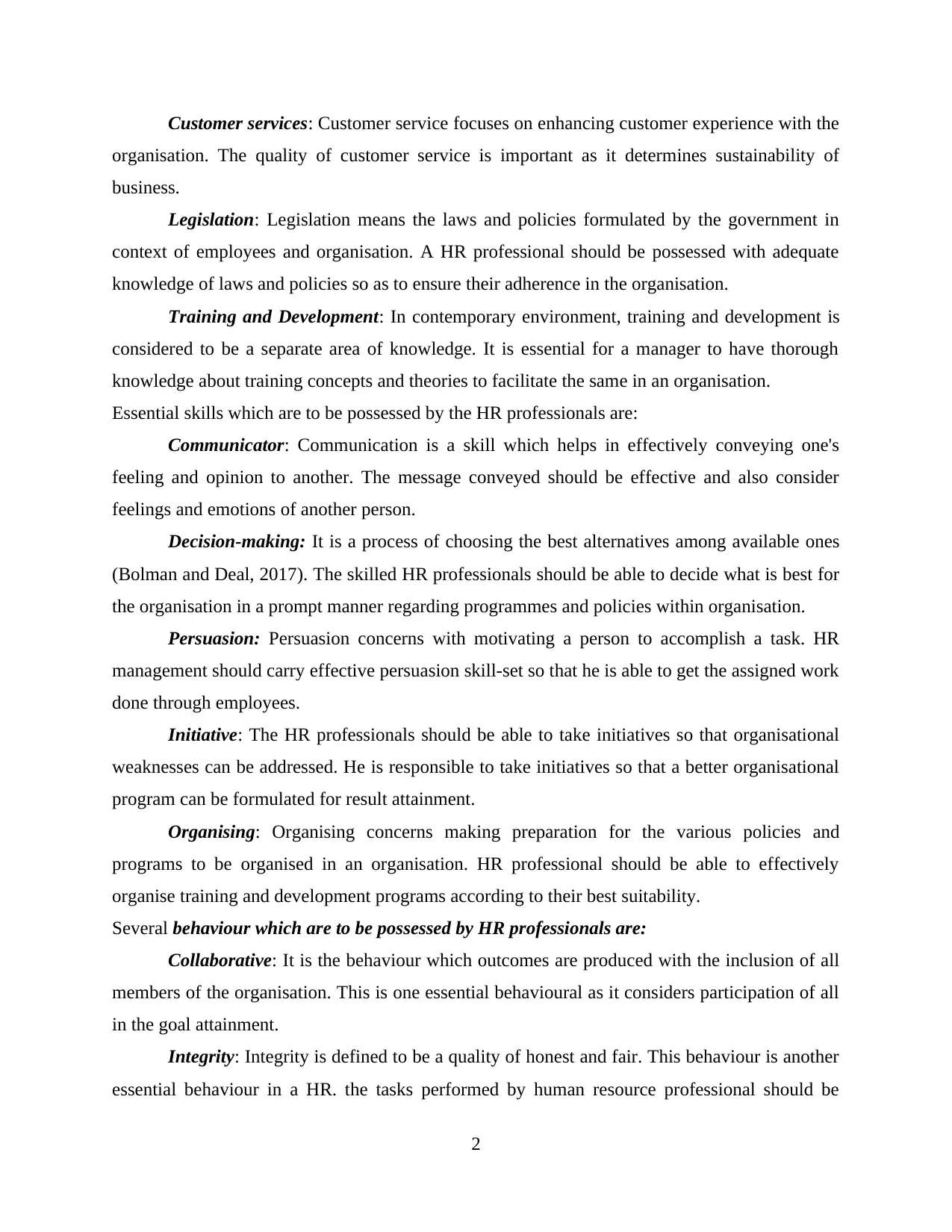
Customer services: Customer service focuses on enhancing customer experience with the
organisation. The quality of customer service is important as it determines sustainability of
business.
Legislation: Legislation means the laws and policies formulated by the government in
context of employees and organisation. A HR professional should be possessed with adequate
knowledge of laws and policies so as to ensure their adherence in the organisation.
Training and Development: In contemporary environment, training and development is
considered to be a separate area of knowledge. It is essential for a manager to have thorough
knowledge about training concepts and theories to facilitate the same in an organisation.
Essential skills which are to be possessed by the HR professionals are:
Communicator: Communication is a skill which helps in effectively conveying one's
feeling and opinion to another. The message conveyed should be effective and also consider
feelings and emotions of another person.
Decision-making: It is a process of choosing the best alternatives among available ones
(Bolman and Deal, 2017). The skilled HR professionals should be able to decide what is best for
the organisation in a prompt manner regarding programmes and policies within organisation.
Persuasion: Persuasion concerns with motivating a person to accomplish a task. HR
management should carry effective persuasion skill-set so that he is able to get the assigned work
done through employees.
Initiative: The HR professionals should be able to take initiatives so that organisational
weaknesses can be addressed. He is responsible to take initiatives so that a better organisational
program can be formulated for result attainment.
Organising: Organising concerns making preparation for the various policies and
programs to be organised in an organisation. HR professional should be able to effectively
organise training and development programs according to their best suitability.
Several behaviour which are to be possessed by HR professionals are:
Collaborative: It is the behaviour which outcomes are produced with the inclusion of all
members of the organisation. This is one essential behavioural as it considers participation of all
in the goal attainment.
Integrity: Integrity is defined to be a quality of honest and fair. This behaviour is another
essential behaviour in a HR. the tasks performed by human resource professional should be
2
organisation. The quality of customer service is important as it determines sustainability of
business.
Legislation: Legislation means the laws and policies formulated by the government in
context of employees and organisation. A HR professional should be possessed with adequate
knowledge of laws and policies so as to ensure their adherence in the organisation.
Training and Development: In contemporary environment, training and development is
considered to be a separate area of knowledge. It is essential for a manager to have thorough
knowledge about training concepts and theories to facilitate the same in an organisation.
Essential skills which are to be possessed by the HR professionals are:
Communicator: Communication is a skill which helps in effectively conveying one's
feeling and opinion to another. The message conveyed should be effective and also consider
feelings and emotions of another person.
Decision-making: It is a process of choosing the best alternatives among available ones
(Bolman and Deal, 2017). The skilled HR professionals should be able to decide what is best for
the organisation in a prompt manner regarding programmes and policies within organisation.
Persuasion: Persuasion concerns with motivating a person to accomplish a task. HR
management should carry effective persuasion skill-set so that he is able to get the assigned work
done through employees.
Initiative: The HR professionals should be able to take initiatives so that organisational
weaknesses can be addressed. He is responsible to take initiatives so that a better organisational
program can be formulated for result attainment.
Organising: Organising concerns making preparation for the various policies and
programs to be organised in an organisation. HR professional should be able to effectively
organise training and development programs according to their best suitability.
Several behaviour which are to be possessed by HR professionals are:
Collaborative: It is the behaviour which outcomes are produced with the inclusion of all
members of the organisation. This is one essential behavioural as it considers participation of all
in the goal attainment.
Integrity: Integrity is defined to be a quality of honest and fair. This behaviour is another
essential behaviour in a HR. the tasks performed by human resource professional should be
2
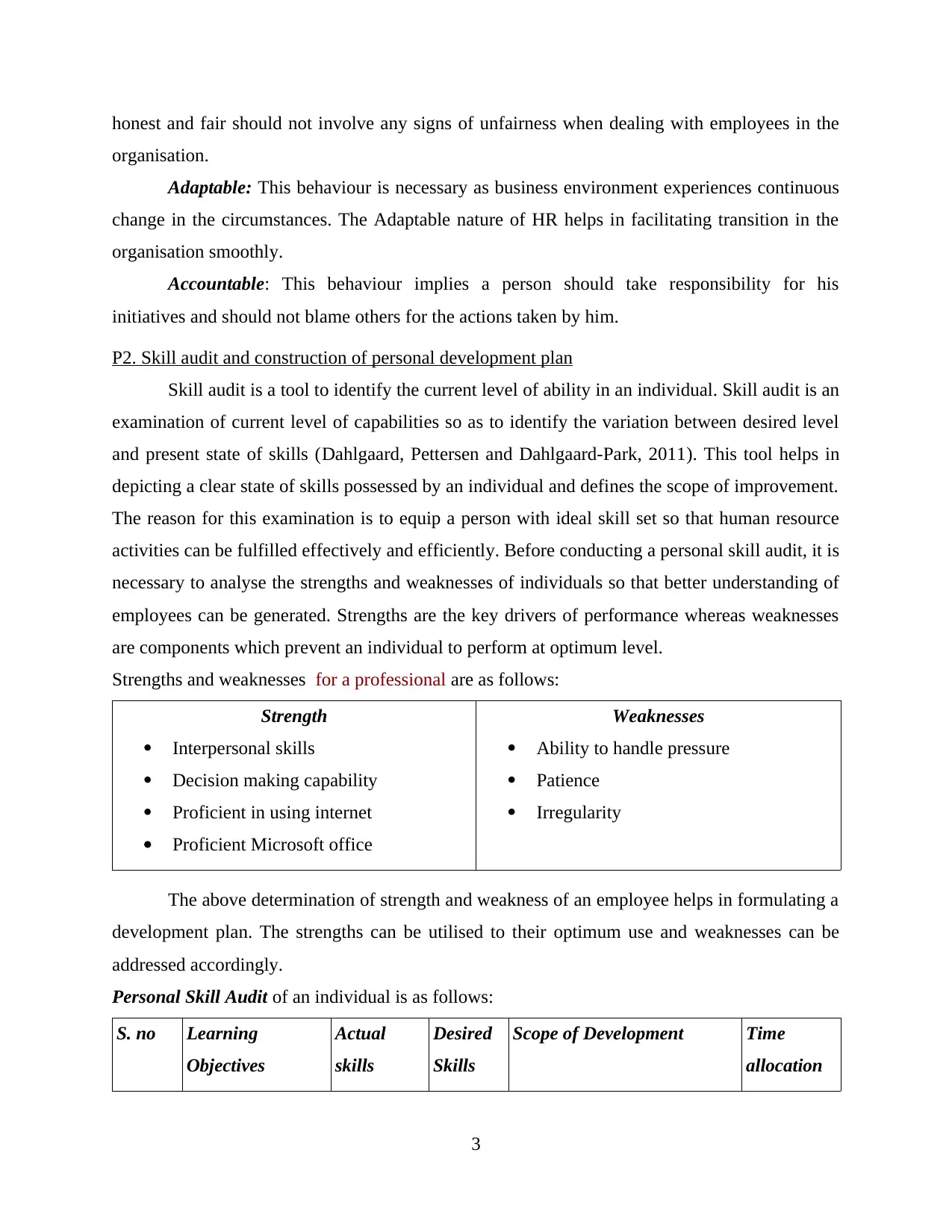
honest and fair should not involve any signs of unfairness when dealing with employees in the
organisation.
Adaptable: This behaviour is necessary as business environment experiences continuous
change in the circumstances. The Adaptable nature of HR helps in facilitating transition in the
organisation smoothly.
Accountable: This behaviour implies a person should take responsibility for his
initiatives and should not blame others for the actions taken by him.
P2. Skill audit and construction of personal development plan
Skill audit is a tool to identify the current level of ability in an individual. Skill audit is an
examination of current level of capabilities so as to identify the variation between desired level
and present state of skills (Dahlgaard, Pettersen and Dahlgaard-Park, 2011). This tool helps in
depicting a clear state of skills possessed by an individual and defines the scope of improvement.
The reason for this examination is to equip a person with ideal skill set so that human resource
activities can be fulfilled effectively and efficiently. Before conducting a personal skill audit, it is
necessary to analyse the strengths and weaknesses of individuals so that better understanding of
employees can be generated. Strengths are the key drivers of performance whereas weaknesses
are components which prevent an individual to perform at optimum level.
Strengths and weaknesses for a professional are as follows:
Strength
Interpersonal skills
Decision making capability
Proficient in using internet
Proficient Microsoft office
Weaknesses
Ability to handle pressure
Patience
Irregularity
The above determination of strength and weakness of an employee helps in formulating a
development plan. The strengths can be utilised to their optimum use and weaknesses can be
addressed accordingly.
Personal Skill Audit of an individual is as follows:
S. no Learning
Objectives
Actual
skills
Desired
Skills
Scope of Development Time
allocation
3
organisation.
Adaptable: This behaviour is necessary as business environment experiences continuous
change in the circumstances. The Adaptable nature of HR helps in facilitating transition in the
organisation smoothly.
Accountable: This behaviour implies a person should take responsibility for his
initiatives and should not blame others for the actions taken by him.
P2. Skill audit and construction of personal development plan
Skill audit is a tool to identify the current level of ability in an individual. Skill audit is an
examination of current level of capabilities so as to identify the variation between desired level
and present state of skills (Dahlgaard, Pettersen and Dahlgaard-Park, 2011). This tool helps in
depicting a clear state of skills possessed by an individual and defines the scope of improvement.
The reason for this examination is to equip a person with ideal skill set so that human resource
activities can be fulfilled effectively and efficiently. Before conducting a personal skill audit, it is
necessary to analyse the strengths and weaknesses of individuals so that better understanding of
employees can be generated. Strengths are the key drivers of performance whereas weaknesses
are components which prevent an individual to perform at optimum level.
Strengths and weaknesses for a professional are as follows:
Strength
Interpersonal skills
Decision making capability
Proficient in using internet
Proficient Microsoft office
Weaknesses
Ability to handle pressure
Patience
Irregularity
The above determination of strength and weakness of an employee helps in formulating a
development plan. The strengths can be utilised to their optimum use and weaknesses can be
addressed accordingly.
Personal Skill Audit of an individual is as follows:
S. no Learning
Objectives
Actual
skills
Desired
Skills
Scope of Development Time
allocation
3
⊘ This is a preview!⊘
Do you want full access?
Subscribe today to unlock all pages.

Trusted by 1+ million students worldwide
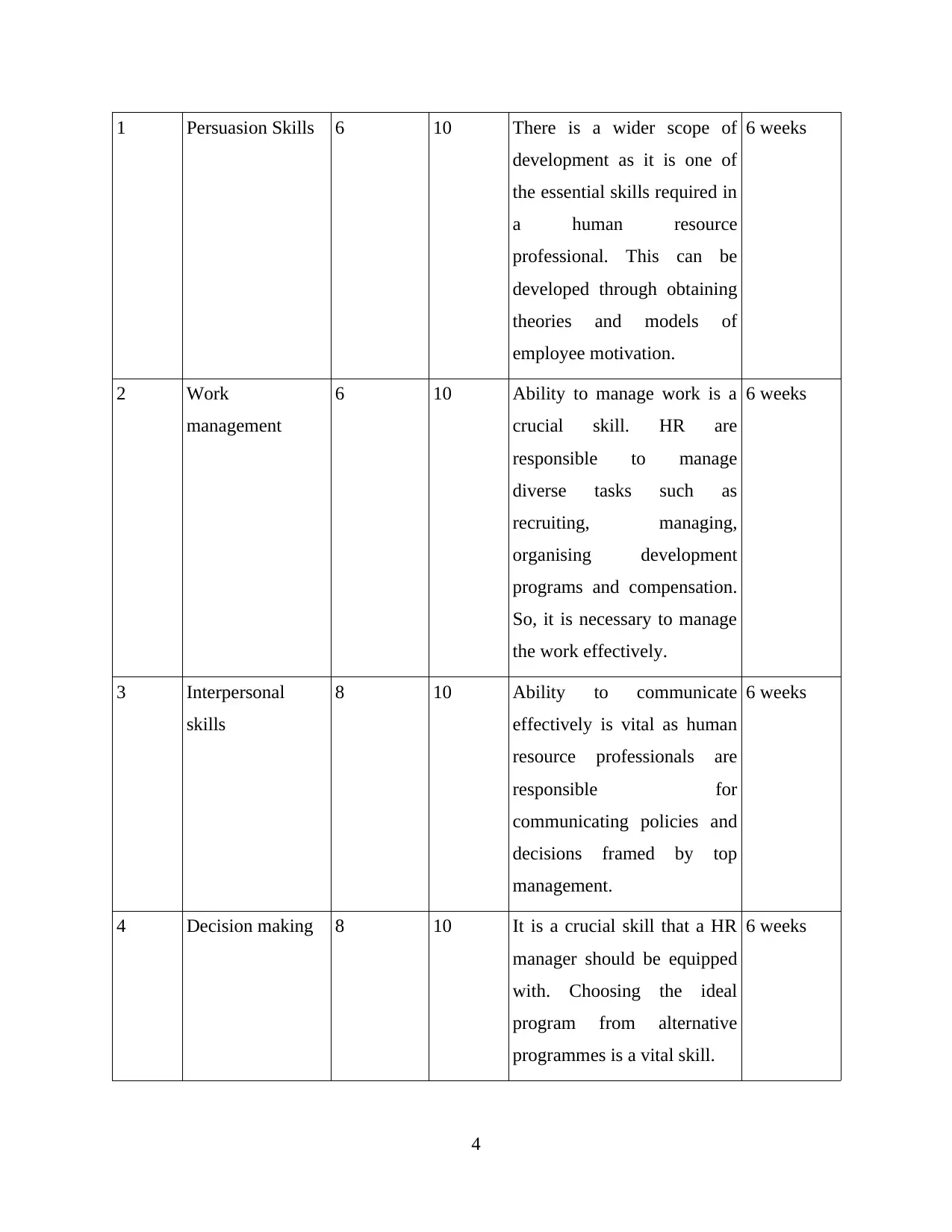
1 Persuasion Skills 6 10 There is a wider scope of
development as it is one of
the essential skills required in
a human resource
professional. This can be
developed through obtaining
theories and models of
employee motivation.
6 weeks
2 Work
management
6 10 Ability to manage work is a
crucial skill. HR are
responsible to manage
diverse tasks such as
recruiting, managing,
organising development
programs and compensation.
So, it is necessary to manage
the work effectively.
6 weeks
3 Interpersonal
skills
8 10 Ability to communicate
effectively is vital as human
resource professionals are
responsible for
communicating policies and
decisions framed by top
management.
6 weeks
4 Decision making 8 10 It is a crucial skill that a HR
manager should be equipped
with. Choosing the ideal
program from alternative
programmes is a vital skill.
6 weeks
4
development as it is one of
the essential skills required in
a human resource
professional. This can be
developed through obtaining
theories and models of
employee motivation.
6 weeks
2 Work
management
6 10 Ability to manage work is a
crucial skill. HR are
responsible to manage
diverse tasks such as
recruiting, managing,
organising development
programs and compensation.
So, it is necessary to manage
the work effectively.
6 weeks
3 Interpersonal
skills
8 10 Ability to communicate
effectively is vital as human
resource professionals are
responsible for
communicating policies and
decisions framed by top
management.
6 weeks
4 Decision making 8 10 It is a crucial skill that a HR
manager should be equipped
with. Choosing the ideal
program from alternative
programmes is a vital skill.
6 weeks
4
Paraphrase This Document
Need a fresh take? Get an instant paraphrase of this document with our AI Paraphraser
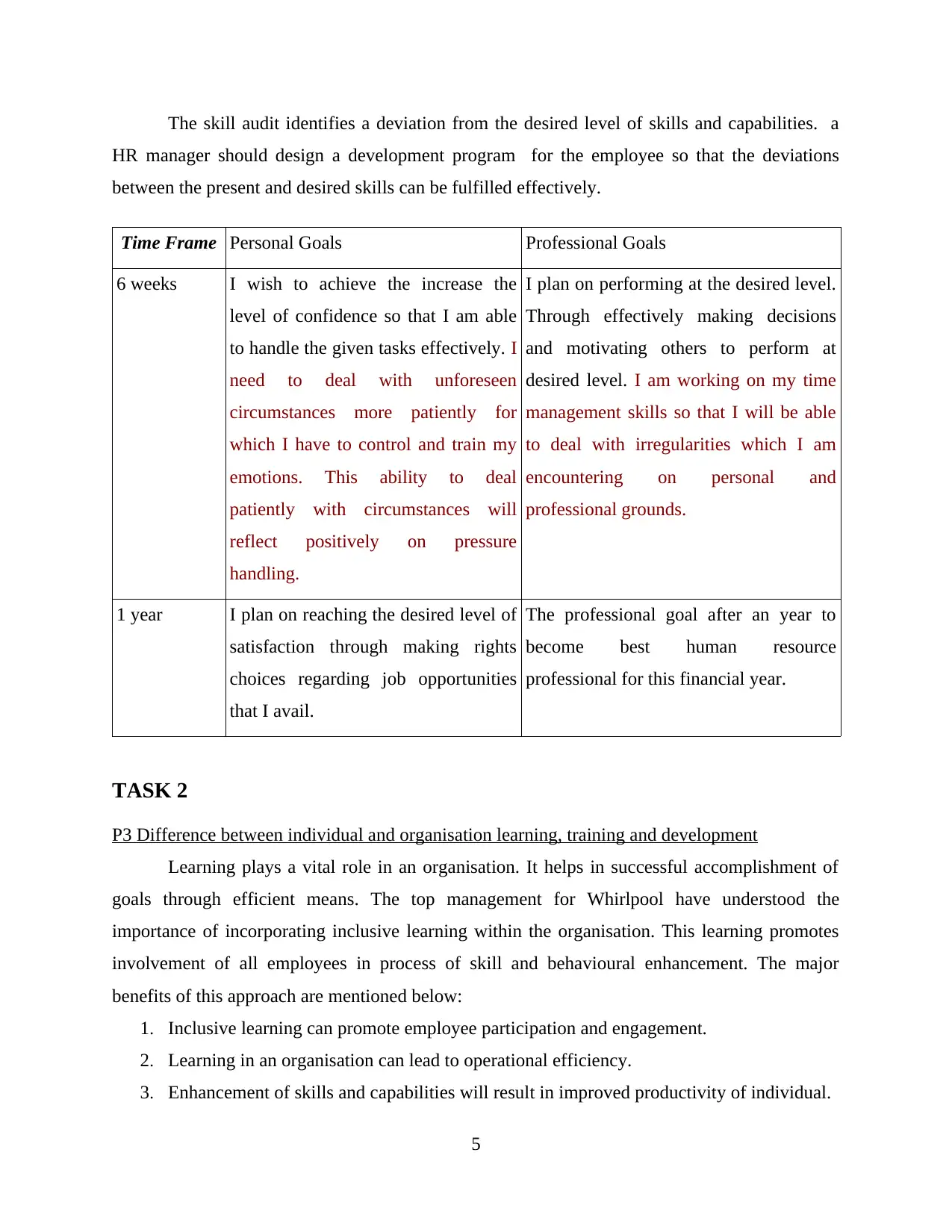
The skill audit identifies a deviation from the desired level of skills and capabilities. a
HR manager should design a development program for the employee so that the deviations
between the present and desired skills can be fulfilled effectively.
Time Frame Personal Goals Professional Goals
6 weeks I wish to achieve the increase the
level of confidence so that I am able
to handle the given tasks effectively. I
need to deal with unforeseen
circumstances more patiently for
which I have to control and train my
emotions. This ability to deal
patiently with circumstances will
reflect positively on pressure
handling.
I plan on performing at the desired level.
Through effectively making decisions
and motivating others to perform at
desired level. I am working on my time
management skills so that I will be able
to deal with irregularities which I am
encountering on personal and
professional grounds.
1 year I plan on reaching the desired level of
satisfaction through making rights
choices regarding job opportunities
that I avail.
The professional goal after an year to
become best human resource
professional for this financial year.
TASK 2
P3 Difference between individual and organisation learning, training and development
Learning plays a vital role in an organisation. It helps in successful accomplishment of
goals through efficient means. The top management for Whirlpool have understood the
importance of incorporating inclusive learning within the organisation. This learning promotes
involvement of all employees in process of skill and behavioural enhancement. The major
benefits of this approach are mentioned below:
1. Inclusive learning can promote employee participation and engagement.
2. Learning in an organisation can lead to operational efficiency.
3. Enhancement of skills and capabilities will result in improved productivity of individual.
5
HR manager should design a development program for the employee so that the deviations
between the present and desired skills can be fulfilled effectively.
Time Frame Personal Goals Professional Goals
6 weeks I wish to achieve the increase the
level of confidence so that I am able
to handle the given tasks effectively. I
need to deal with unforeseen
circumstances more patiently for
which I have to control and train my
emotions. This ability to deal
patiently with circumstances will
reflect positively on pressure
handling.
I plan on performing at the desired level.
Through effectively making decisions
and motivating others to perform at
desired level. I am working on my time
management skills so that I will be able
to deal with irregularities which I am
encountering on personal and
professional grounds.
1 year I plan on reaching the desired level of
satisfaction through making rights
choices regarding job opportunities
that I avail.
The professional goal after an year to
become best human resource
professional for this financial year.
TASK 2
P3 Difference between individual and organisation learning, training and development
Learning plays a vital role in an organisation. It helps in successful accomplishment of
goals through efficient means. The top management for Whirlpool have understood the
importance of incorporating inclusive learning within the organisation. This learning promotes
involvement of all employees in process of skill and behavioural enhancement. The major
benefits of this approach are mentioned below:
1. Inclusive learning can promote employee participation and engagement.
2. Learning in an organisation can lead to operational efficiency.
3. Enhancement of skills and capabilities will result in improved productivity of individual.
5
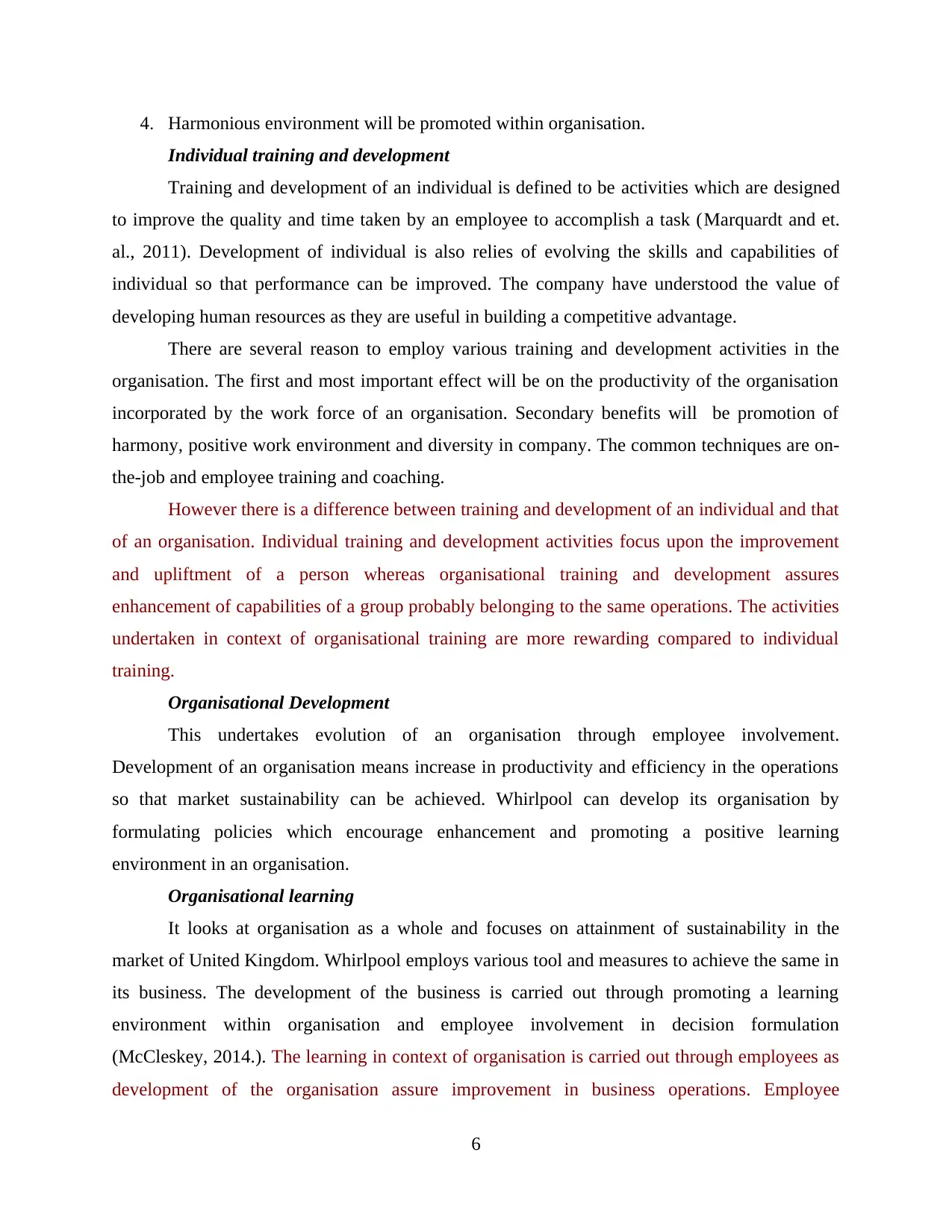
4. Harmonious environment will be promoted within organisation.
Individual training and development
Training and development of an individual is defined to be activities which are designed
to improve the quality and time taken by an employee to accomplish a task (Marquardt and et.
al., 2011). Development of individual is also relies of evolving the skills and capabilities of
individual so that performance can be improved. The company have understood the value of
developing human resources as they are useful in building a competitive advantage.
There are several reason to employ various training and development activities in the
organisation. The first and most important effect will be on the productivity of the organisation
incorporated by the work force of an organisation. Secondary benefits will be promotion of
harmony, positive work environment and diversity in company. The common techniques are on-
the-job and employee training and coaching.
However there is a difference between training and development of an individual and that
of an organisation. Individual training and development activities focus upon the improvement
and upliftment of a person whereas organisational training and development assures
enhancement of capabilities of a group probably belonging to the same operations. The activities
undertaken in context of organisational training are more rewarding compared to individual
training.
Organisational Development
This undertakes evolution of an organisation through employee involvement.
Development of an organisation means increase in productivity and efficiency in the operations
so that market sustainability can be achieved. Whirlpool can develop its organisation by
formulating policies which encourage enhancement and promoting a positive learning
environment in an organisation.
Organisational learning
It looks at organisation as a whole and focuses on attainment of sustainability in the
market of United Kingdom. Whirlpool employs various tool and measures to achieve the same in
its business. The development of the business is carried out through promoting a learning
environment within organisation and employee involvement in decision formulation
(McCleskey, 2014.). The learning in context of organisation is carried out through employees as
development of the organisation assure improvement in business operations. Employee
6
Individual training and development
Training and development of an individual is defined to be activities which are designed
to improve the quality and time taken by an employee to accomplish a task (Marquardt and et.
al., 2011). Development of individual is also relies of evolving the skills and capabilities of
individual so that performance can be improved. The company have understood the value of
developing human resources as they are useful in building a competitive advantage.
There are several reason to employ various training and development activities in the
organisation. The first and most important effect will be on the productivity of the organisation
incorporated by the work force of an organisation. Secondary benefits will be promotion of
harmony, positive work environment and diversity in company. The common techniques are on-
the-job and employee training and coaching.
However there is a difference between training and development of an individual and that
of an organisation. Individual training and development activities focus upon the improvement
and upliftment of a person whereas organisational training and development assures
enhancement of capabilities of a group probably belonging to the same operations. The activities
undertaken in context of organisational training are more rewarding compared to individual
training.
Organisational Development
This undertakes evolution of an organisation through employee involvement.
Development of an organisation means increase in productivity and efficiency in the operations
so that market sustainability can be achieved. Whirlpool can develop its organisation by
formulating policies which encourage enhancement and promoting a positive learning
environment in an organisation.
Organisational learning
It looks at organisation as a whole and focuses on attainment of sustainability in the
market of United Kingdom. Whirlpool employs various tool and measures to achieve the same in
its business. The development of the business is carried out through promoting a learning
environment within organisation and employee involvement in decision formulation
(McCleskey, 2014.). The learning in context of organisation is carried out through employees as
development of the organisation assure improvement in business operations. Employee
6
⊘ This is a preview!⊘
Do you want full access?
Subscribe today to unlock all pages.

Trusted by 1+ million students worldwide
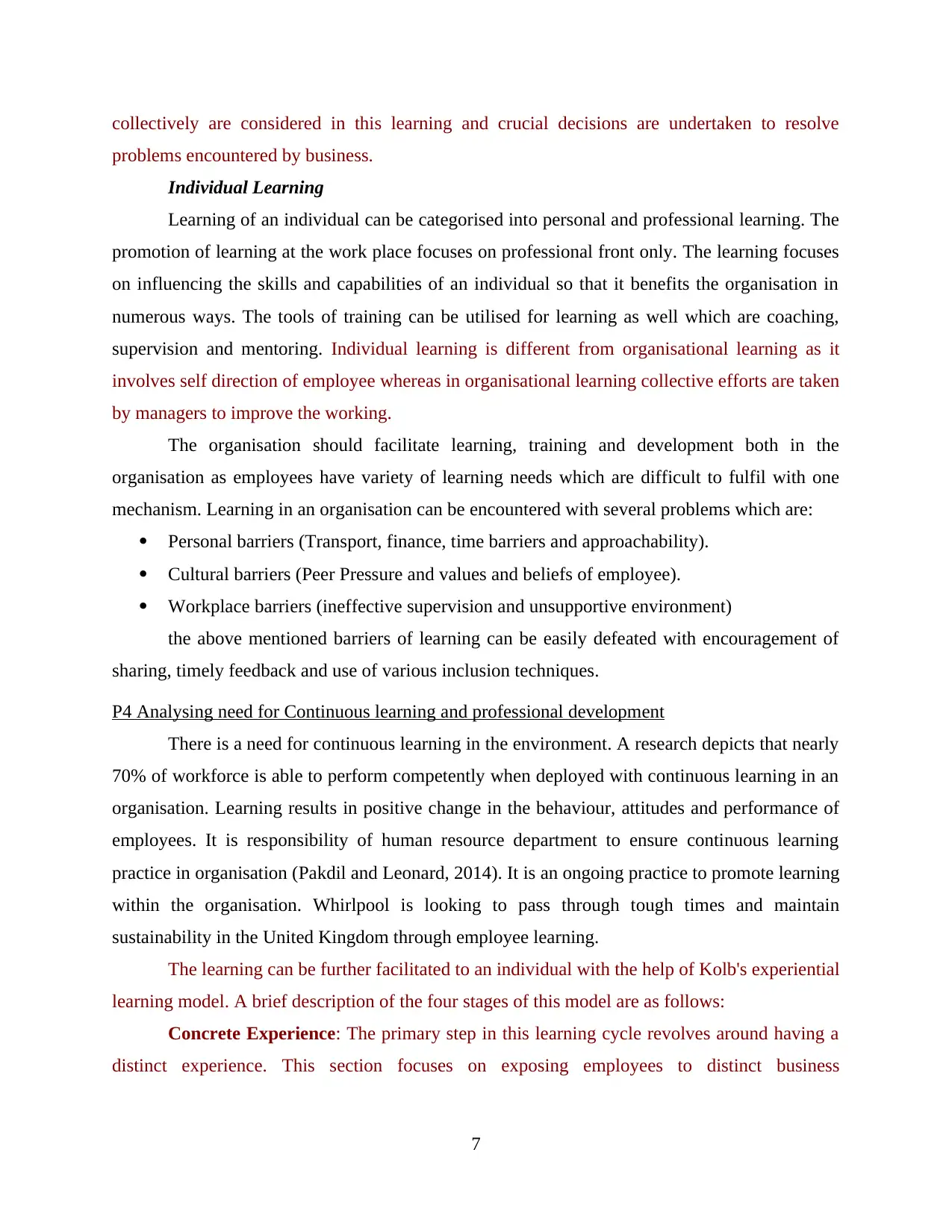
collectively are considered in this learning and crucial decisions are undertaken to resolve
problems encountered by business.
Individual Learning
Learning of an individual can be categorised into personal and professional learning. The
promotion of learning at the work place focuses on professional front only. The learning focuses
on influencing the skills and capabilities of an individual so that it benefits the organisation in
numerous ways. The tools of training can be utilised for learning as well which are coaching,
supervision and mentoring. Individual learning is different from organisational learning as it
involves self direction of employee whereas in organisational learning collective efforts are taken
by managers to improve the working.
The organisation should facilitate learning, training and development both in the
organisation as employees have variety of learning needs which are difficult to fulfil with one
mechanism. Learning in an organisation can be encountered with several problems which are:
Personal barriers (Transport, finance, time barriers and approachability).
Cultural barriers (Peer Pressure and values and beliefs of employee).
Workplace barriers (ineffective supervision and unsupportive environment)
the above mentioned barriers of learning can be easily defeated with encouragement of
sharing, timely feedback and use of various inclusion techniques.
P4 Analysing need for Continuous learning and professional development
There is a need for continuous learning in the environment. A research depicts that nearly
70% of workforce is able to perform competently when deployed with continuous learning in an
organisation. Learning results in positive change in the behaviour, attitudes and performance of
employees. It is responsibility of human resource department to ensure continuous learning
practice in organisation (Pakdil and Leonard, 2014). It is an ongoing practice to promote learning
within the organisation. Whirlpool is looking to pass through tough times and maintain
sustainability in the United Kingdom through employee learning.
The learning can be further facilitated to an individual with the help of Kolb's experiential
learning model. A brief description of the four stages of this model are as follows:
Concrete Experience: The primary step in this learning cycle revolves around having a
distinct experience. This section focuses on exposing employees to distinct business
7
problems encountered by business.
Individual Learning
Learning of an individual can be categorised into personal and professional learning. The
promotion of learning at the work place focuses on professional front only. The learning focuses
on influencing the skills and capabilities of an individual so that it benefits the organisation in
numerous ways. The tools of training can be utilised for learning as well which are coaching,
supervision and mentoring. Individual learning is different from organisational learning as it
involves self direction of employee whereas in organisational learning collective efforts are taken
by managers to improve the working.
The organisation should facilitate learning, training and development both in the
organisation as employees have variety of learning needs which are difficult to fulfil with one
mechanism. Learning in an organisation can be encountered with several problems which are:
Personal barriers (Transport, finance, time barriers and approachability).
Cultural barriers (Peer Pressure and values and beliefs of employee).
Workplace barriers (ineffective supervision and unsupportive environment)
the above mentioned barriers of learning can be easily defeated with encouragement of
sharing, timely feedback and use of various inclusion techniques.
P4 Analysing need for Continuous learning and professional development
There is a need for continuous learning in the environment. A research depicts that nearly
70% of workforce is able to perform competently when deployed with continuous learning in an
organisation. Learning results in positive change in the behaviour, attitudes and performance of
employees. It is responsibility of human resource department to ensure continuous learning
practice in organisation (Pakdil and Leonard, 2014). It is an ongoing practice to promote learning
within the organisation. Whirlpool is looking to pass through tough times and maintain
sustainability in the United Kingdom through employee learning.
The learning can be further facilitated to an individual with the help of Kolb's experiential
learning model. A brief description of the four stages of this model are as follows:
Concrete Experience: The primary step in this learning cycle revolves around having a
distinct experience. This section focuses on exposing employees to distinct business
7
Paraphrase This Document
Need a fresh take? Get an instant paraphrase of this document with our AI Paraphraser
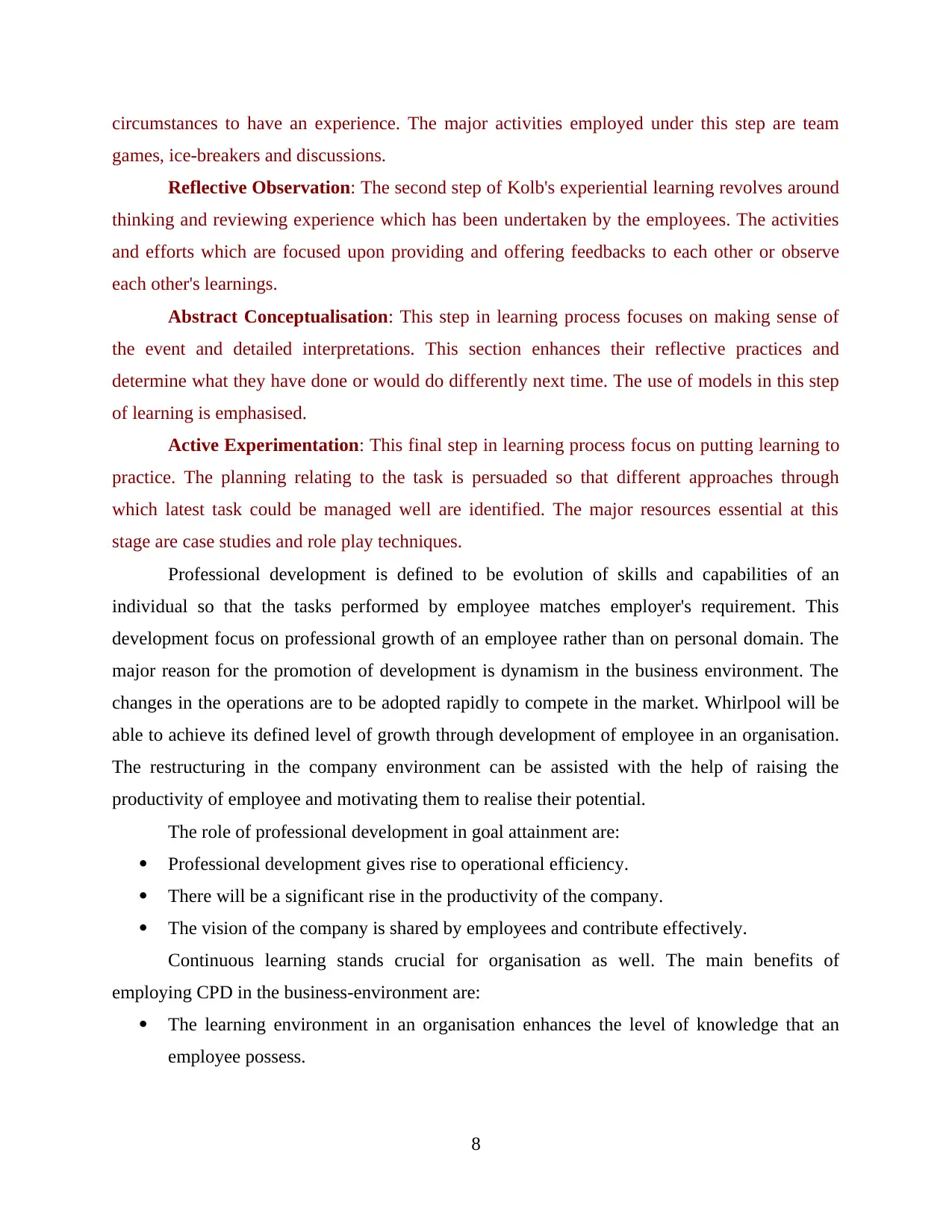
circumstances to have an experience. The major activities employed under this step are team
games, ice-breakers and discussions.
Reflective Observation: The second step of Kolb's experiential learning revolves around
thinking and reviewing experience which has been undertaken by the employees. The activities
and efforts which are focused upon providing and offering feedbacks to each other or observe
each other's learnings.
Abstract Conceptualisation: This step in learning process focuses on making sense of
the event and detailed interpretations. This section enhances their reflective practices and
determine what they have done or would do differently next time. The use of models in this step
of learning is emphasised.
Active Experimentation: This final step in learning process focus on putting learning to
practice. The planning relating to the task is persuaded so that different approaches through
which latest task could be managed well are identified. The major resources essential at this
stage are case studies and role play techniques.
Professional development is defined to be evolution of skills and capabilities of an
individual so that the tasks performed by employee matches employer's requirement. This
development focus on professional growth of an employee rather than on personal domain. The
major reason for the promotion of development is dynamism in the business environment. The
changes in the operations are to be adopted rapidly to compete in the market. Whirlpool will be
able to achieve its defined level of growth through development of employee in an organisation.
The restructuring in the company environment can be assisted with the help of raising the
productivity of employee and motivating them to realise their potential.
The role of professional development in goal attainment are:
Professional development gives rise to operational efficiency.
There will be a significant rise in the productivity of the company.
The vision of the company is shared by employees and contribute effectively.
Continuous learning stands crucial for organisation as well. The main benefits of
employing CPD in the business-environment are:
The learning environment in an organisation enhances the level of knowledge that an
employee possess.
8
games, ice-breakers and discussions.
Reflective Observation: The second step of Kolb's experiential learning revolves around
thinking and reviewing experience which has been undertaken by the employees. The activities
and efforts which are focused upon providing and offering feedbacks to each other or observe
each other's learnings.
Abstract Conceptualisation: This step in learning process focuses on making sense of
the event and detailed interpretations. This section enhances their reflective practices and
determine what they have done or would do differently next time. The use of models in this step
of learning is emphasised.
Active Experimentation: This final step in learning process focus on putting learning to
practice. The planning relating to the task is persuaded so that different approaches through
which latest task could be managed well are identified. The major resources essential at this
stage are case studies and role play techniques.
Professional development is defined to be evolution of skills and capabilities of an
individual so that the tasks performed by employee matches employer's requirement. This
development focus on professional growth of an employee rather than on personal domain. The
major reason for the promotion of development is dynamism in the business environment. The
changes in the operations are to be adopted rapidly to compete in the market. Whirlpool will be
able to achieve its defined level of growth through development of employee in an organisation.
The restructuring in the company environment can be assisted with the help of raising the
productivity of employee and motivating them to realise their potential.
The role of professional development in goal attainment are:
Professional development gives rise to operational efficiency.
There will be a significant rise in the productivity of the company.
The vision of the company is shared by employees and contribute effectively.
Continuous learning stands crucial for organisation as well. The main benefits of
employing CPD in the business-environment are:
The learning environment in an organisation enhances the level of knowledge that an
employee possess.
8
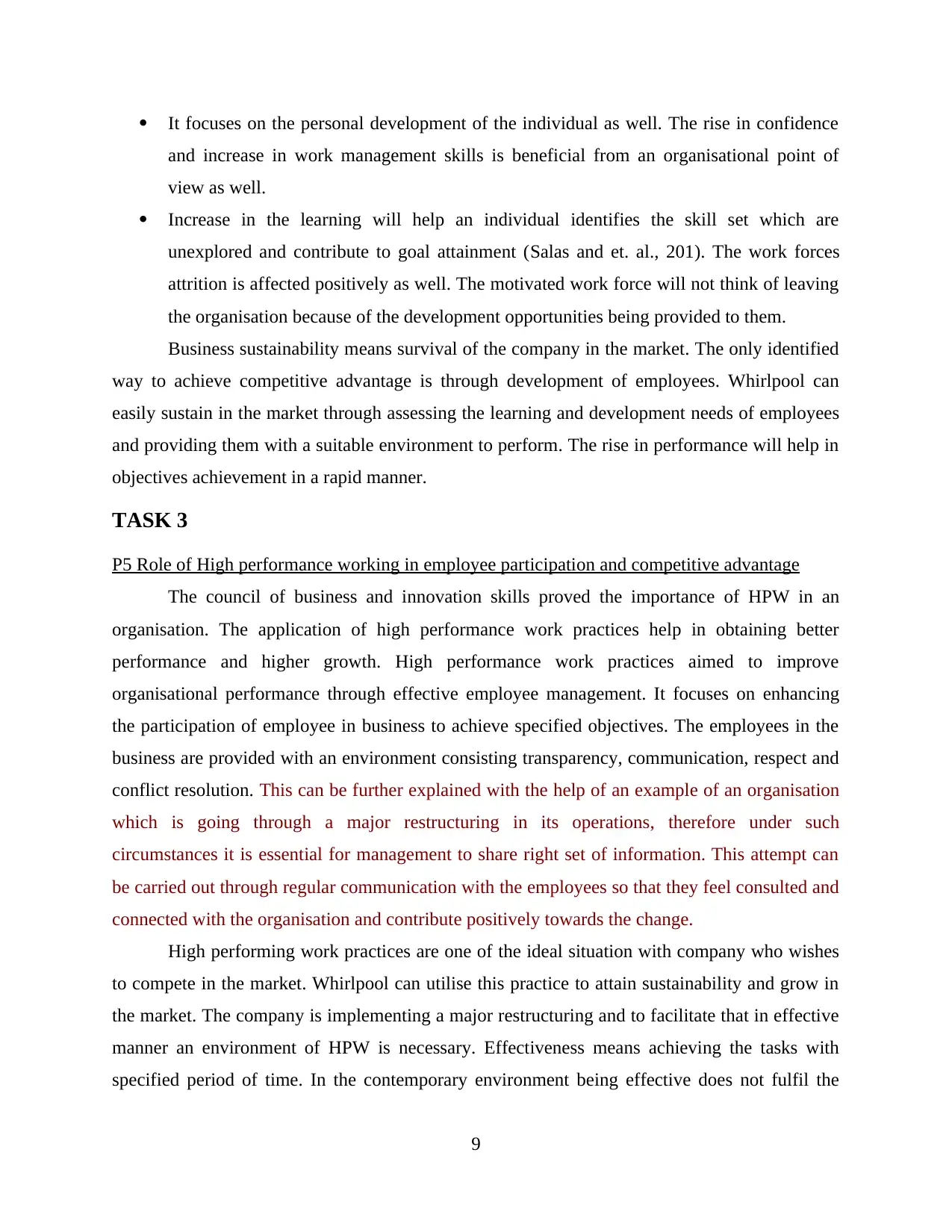
It focuses on the personal development of the individual as well. The rise in confidence
and increase in work management skills is beneficial from an organisational point of
view as well.
Increase in the learning will help an individual identifies the skill set which are
unexplored and contribute to goal attainment (Salas and et. al., 201). The work forces
attrition is affected positively as well. The motivated work force will not think of leaving
the organisation because of the development opportunities being provided to them.
Business sustainability means survival of the company in the market. The only identified
way to achieve competitive advantage is through development of employees. Whirlpool can
easily sustain in the market through assessing the learning and development needs of employees
and providing them with a suitable environment to perform. The rise in performance will help in
objectives achievement in a rapid manner.
TASK 3
P5 Role of High performance working in employee participation and competitive advantage
The council of business and innovation skills proved the importance of HPW in an
organisation. The application of high performance work practices help in obtaining better
performance and higher growth. High performance work practices aimed to improve
organisational performance through effective employee management. It focuses on enhancing
the participation of employee in business to achieve specified objectives. The employees in the
business are provided with an environment consisting transparency, communication, respect and
conflict resolution. This can be further explained with the help of an example of an organisation
which is going through a major restructuring in its operations, therefore under such
circumstances it is essential for management to share right set of information. This attempt can
be carried out through regular communication with the employees so that they feel consulted and
connected with the organisation and contribute positively towards the change.
High performing work practices are one of the ideal situation with company who wishes
to compete in the market. Whirlpool can utilise this practice to attain sustainability and grow in
the market. The company is implementing a major restructuring and to facilitate that in effective
manner an environment of HPW is necessary. Effectiveness means achieving the tasks with
specified period of time. In the contemporary environment being effective does not fulfil the
9
and increase in work management skills is beneficial from an organisational point of
view as well.
Increase in the learning will help an individual identifies the skill set which are
unexplored and contribute to goal attainment (Salas and et. al., 201). The work forces
attrition is affected positively as well. The motivated work force will not think of leaving
the organisation because of the development opportunities being provided to them.
Business sustainability means survival of the company in the market. The only identified
way to achieve competitive advantage is through development of employees. Whirlpool can
easily sustain in the market through assessing the learning and development needs of employees
and providing them with a suitable environment to perform. The rise in performance will help in
objectives achievement in a rapid manner.
TASK 3
P5 Role of High performance working in employee participation and competitive advantage
The council of business and innovation skills proved the importance of HPW in an
organisation. The application of high performance work practices help in obtaining better
performance and higher growth. High performance work practices aimed to improve
organisational performance through effective employee management. It focuses on enhancing
the participation of employee in business to achieve specified objectives. The employees in the
business are provided with an environment consisting transparency, communication, respect and
conflict resolution. This can be further explained with the help of an example of an organisation
which is going through a major restructuring in its operations, therefore under such
circumstances it is essential for management to share right set of information. This attempt can
be carried out through regular communication with the employees so that they feel consulted and
connected with the organisation and contribute positively towards the change.
High performing work practices are one of the ideal situation with company who wishes
to compete in the market. Whirlpool can utilise this practice to attain sustainability and grow in
the market. The company is implementing a major restructuring and to facilitate that in effective
manner an environment of HPW is necessary. Effectiveness means achieving the tasks with
specified period of time. In the contemporary environment being effective does not fulfil the
9
⊘ This is a preview!⊘
Do you want full access?
Subscribe today to unlock all pages.

Trusted by 1+ million students worldwide
1 out of 19
Related Documents
Your All-in-One AI-Powered Toolkit for Academic Success.
+13062052269
info@desklib.com
Available 24*7 on WhatsApp / Email
![[object Object]](/_next/static/media/star-bottom.7253800d.svg)
Unlock your academic potential
Copyright © 2020–2025 A2Z Services. All Rights Reserved. Developed and managed by ZUCOL.





